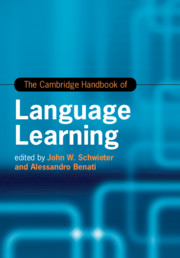Book contents
- The Cambridge Handbook of Language Learning
- Cambridge Handbooks in Language and Linguistics
- The Cambridge Handbook of Language Learning
- Copyright page
- Contents
- Figures
- Tables
- Contributors
- Acknowledgements
- Introduction
- Part I Theories
- Part II Methods
- Part III Skill Development
- Part IV Individual Differences
- Part V Pedagogical Interventions and Approaches
- 20 Pedagogical Interventions to L2 Grammar Instruction
- 21 Task-Based Language Learning
- 22 Task and Syllabus Design for Morphologically Complex Languages
- 23 Proficiency Guidelines and Frameworks
- 24 Technology-Mediated Language Learning
- 25 Content-Based L2 Teaching
- 26 Conceptions of L2 Learning in Critical Language Pedagogy
- Part VI Context and Environment
- Part VII Moving Forward
- Index
- References
24 - Technology-Mediated Language Learning
from Part V - Pedagogical Interventions and Approaches
Published online by Cambridge University Press: 25 June 2019
- The Cambridge Handbook of Language Learning
- Cambridge Handbooks in Language and Linguistics
- The Cambridge Handbook of Language Learning
- Copyright page
- Contents
- Figures
- Tables
- Contributors
- Acknowledgements
- Introduction
- Part I Theories
- Part II Methods
- Part III Skill Development
- Part IV Individual Differences
- Part V Pedagogical Interventions and Approaches
- 20 Pedagogical Interventions to L2 Grammar Instruction
- 21 Task-Based Language Learning
- 22 Task and Syllabus Design for Morphologically Complex Languages
- 23 Proficiency Guidelines and Frameworks
- 24 Technology-Mediated Language Learning
- 25 Content-Based L2 Teaching
- 26 Conceptions of L2 Learning in Critical Language Pedagogy
- Part VI Context and Environment
- Part VII Moving Forward
- Index
- References
Summary
Technology-mediated language learning today encompasses multifaceted issues connected with the role of digital technologies in mediating opportunities for language learning. Such opportunities arrive when teachers assign digital learning materials and tasks in a face-to-face classroom, when language programmes develop online courses that include computer-mediated interactions, and when language learners seek opportunities for study, help, and social interactions on their own. Each of these three uses of technology has arisen within a particular milieu of research and practice in applied linguistics. However, today the three intersect in dynamic and complex ways. Moreover, the areas and their intersections converge with aspects of second language studies including instructed second language acquisition, language assessment, learner autonomy and motivation, as well as informal language learning. This chapter examines the practices, issues, findings, and challenges in each of these three interconnected areas, beginning with the classroom, where the study of computer-assisted language learning has its roots in the middle of the twentieth century.
- Type
- Chapter
- Information
- The Cambridge Handbook of Language Learning , pp. 575 - 596Publisher: Cambridge University PressPrint publication year: 2019
References
- 12
- Cited by

